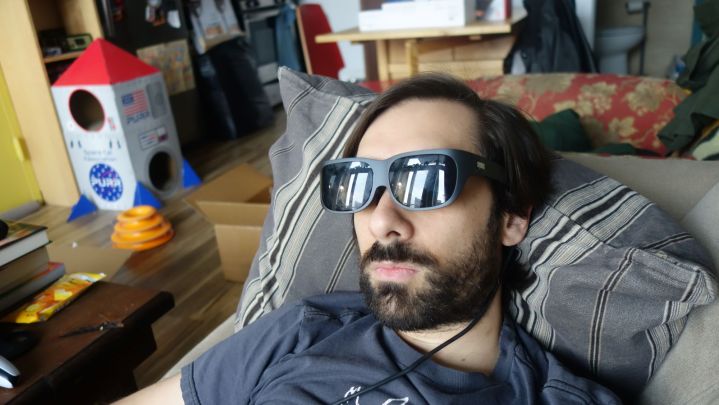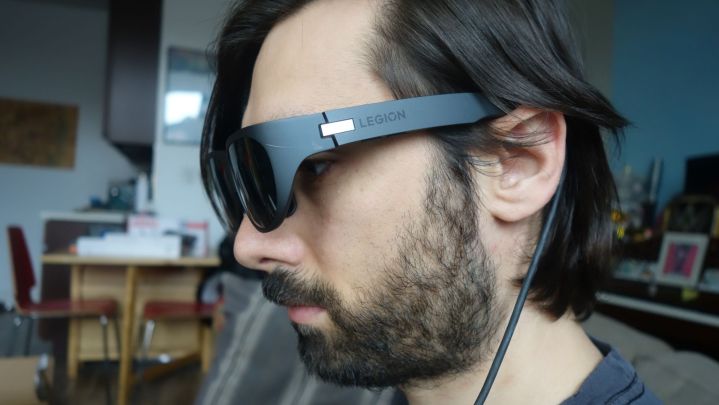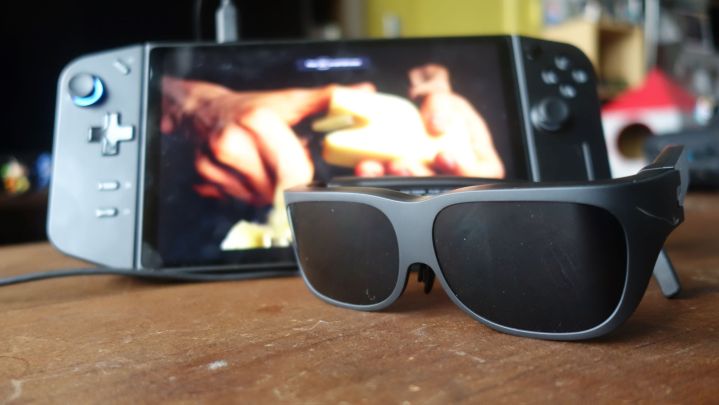It was a Wednesday night and I was as sick as a dog with some mysterious virus. Waves of nausea and brain fog had left me so weak that I couldn’t even sit. I was on my back for the night – and this gave me the perfect opportunity to test out my fancy new AR glasses.
Just a few nights ago, I got a pair of Lenovo’s Legion glasses. I got the shades with my Legion Go and thought I’d use them to enjoy some gaming on a huge 1080p display right in front of my eyes. Since I couldn’t really get out of bed, I decided to tie them down and turn my ceiling into a screen. maybe i’ll run some races forza motorsport or fight in one or two Nickelodeon All-Stars Brawl 2 While laid. I won’t play any of these. Instead, I lay peacefully in the dark while a YouTuber whispered in my ear about malt liquor.
Forget gaming, movies or web browsing. Devices like Legion Glasses have a true killer app: ASMR.
Gaming on Legion Glasses

Legion Glasses are Lenovo’s venture into the emerging AR glasses market. It’s a space that has already given us some strong devices like the XREAL Air 2 as manufacturers are innovating rapidly. Lenovo’s take on the technology is easy to understand: It’s a pair of sunglasses with two micro-OLED displays on the back of the frame. You simply plug it into your device of choice via USB and they magically transform into an external monitor that sits over your face.
It’s an incredibly niche concept that’s been struggling to break into the mainstream wearable market for years, but devices like this indicate that tech companies are getting more serious about it. how serious? The Legion Glass costs just $329, which is $70 less than the XREAL Air 2. There’s a slight price cut, as the latter has a 120Hz refresh rate while Lenovo’s glasses tap 60Hz.
The ambitious idea here is that glasses like this make it feel like you have your own personal movie theater right at home, creating the illusion of a giant screen. It’s no surprise that entertainment is the key selling point for this tech market, with gaming in particular at the forefront. I had tested that idea before I suddenly fell ill, playing some games while lounging comfortably on the couch.
It didn’t take much effort to install it. All I had to do was strap on the glasses and plug them into my Legion Go. That’s it. The glasses themselves don’t require much tinkering. There are no buttons to adjust focus like a VR headset, so I really only had to manage the speaker volume and brightness (both of which are easily controlled via buttons on the temples). Granted, I immediately wished I had more options for making changes to the display. During my testing, the image was always a little blurry for me, especially at the edges of the frame. If I wanted to spend the extra cash, I could get some prescription lenses fitted, but that seems like too much expense for a technical gimmick.

After adjusting to that mild ambiguity, I immediately discovered the potential appeal of such a device. I lay back on my sofa in a comfortable position, my neck resting firmly on the pillow as I lay down, and lay down forza motorsport Through my Legion Go. Racing simulators have become my favorite game over the past month, so this was the perfect game to play in that situation. It’s also something that doesn’t require a lot of reading, which I thought was hard to do considering how small a lot of video game UIs have become these days. After all, it’s not like I can get closer to the screen to see it better.
Do I think everyone should have this experience? Absolutely not. This is the definition of luxury reserved only for those who have hundreds to spend. As I lay down, I thought about how practical a device like this could be for someone recovering from an injury or struggling with limited mobility. There is no tension required on the neck or body when using these, which can be really helpful in specific situations.
And after a few days of testing I would experience that uniqueness firsthand.
asm-ar

Let’s remember that night when I was lying in bed because of an upset stomach. Unable to sleep, I picked up my Legion Go and glasses. I started thinking about how I could use them in a moment to quiet my mind without paying too much attention. A game would be a little more intense for my brain, but ASMR would be exactly what the doctor ordered.
For the uninitiated, ASMR (Autonomous Sensory Meridian Response) refers to a pleasant tingling sensation that some people experience when they hear certain soft noises. This has resulted in a series of content creators over the years who have created an entire genre of ASMR videos. The clips, which have garnered millions of views on YouTube, feature sound artists whispering into binaural microphones and creating relaxing soundscapes. I’ve watched videos like this for years to relieve my anxiety and calm my mind on stressful nights.
At first, I was just wandering around when I told myself I should load an ASMR video onto my Legion glasses. It seemed like a ridiculous thing to do with a $329 piece of technology. It turned out that it was no joke. I loaded up some old standby ASMR videos (from airplane vibes to wine pouring) and immediately found that they were a perfect fit for the device.
This is largely due to its speakers, which are located above each ear. This feature fits well with the binaural audio recording used in most ASMR videos. Having the glasses on my face will also keep me from looking at my phone or doing anything else while listening. I could actually just close my eyes and let the sounds in, allowing me to have a more intense experience with something that has helped me relax for years.
The absurdity of this is not lost on me. When you go to read hands-on experiences of a hot new tech product, you probably don’t expect to read how many great YouTube videos are played on it. However, this explains what’s ultimately interesting about devices like the Legion Glasses. There are plenty of creative use cases for it that go far beyond the unnecessary luxury of playing games on glasses instead of your TV. I don’t expect I’ll be using mine for long gaming sessions anytime in the near future, but I’ll definitely have them handy the next time I’m stressed (and trust me, that’ll be a lot of times). This shouldn’t convince you to drop hundreds on a pair of your own, but it should help you imagine what kinds of personal routines can be enhanced with the right tech toy.


